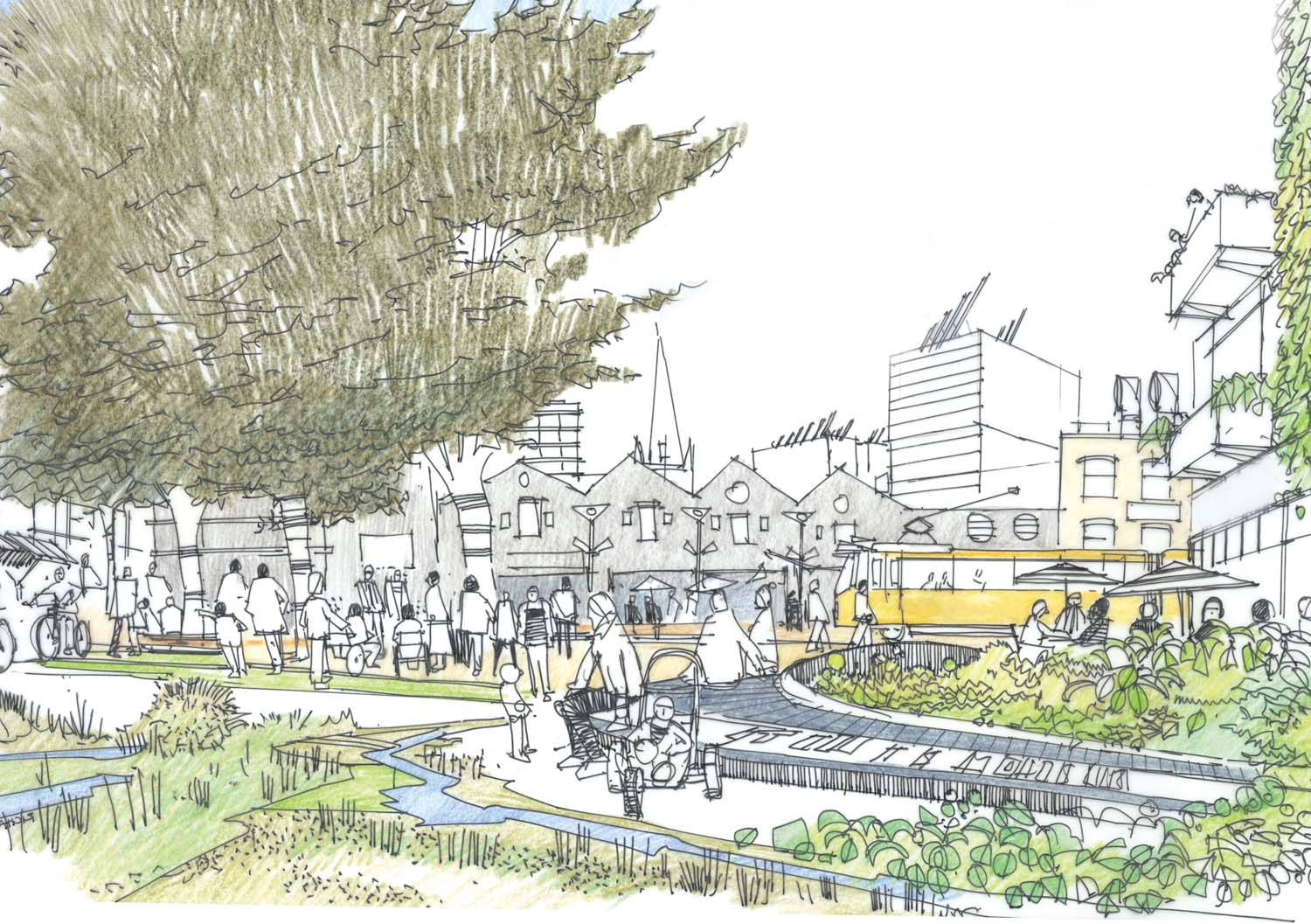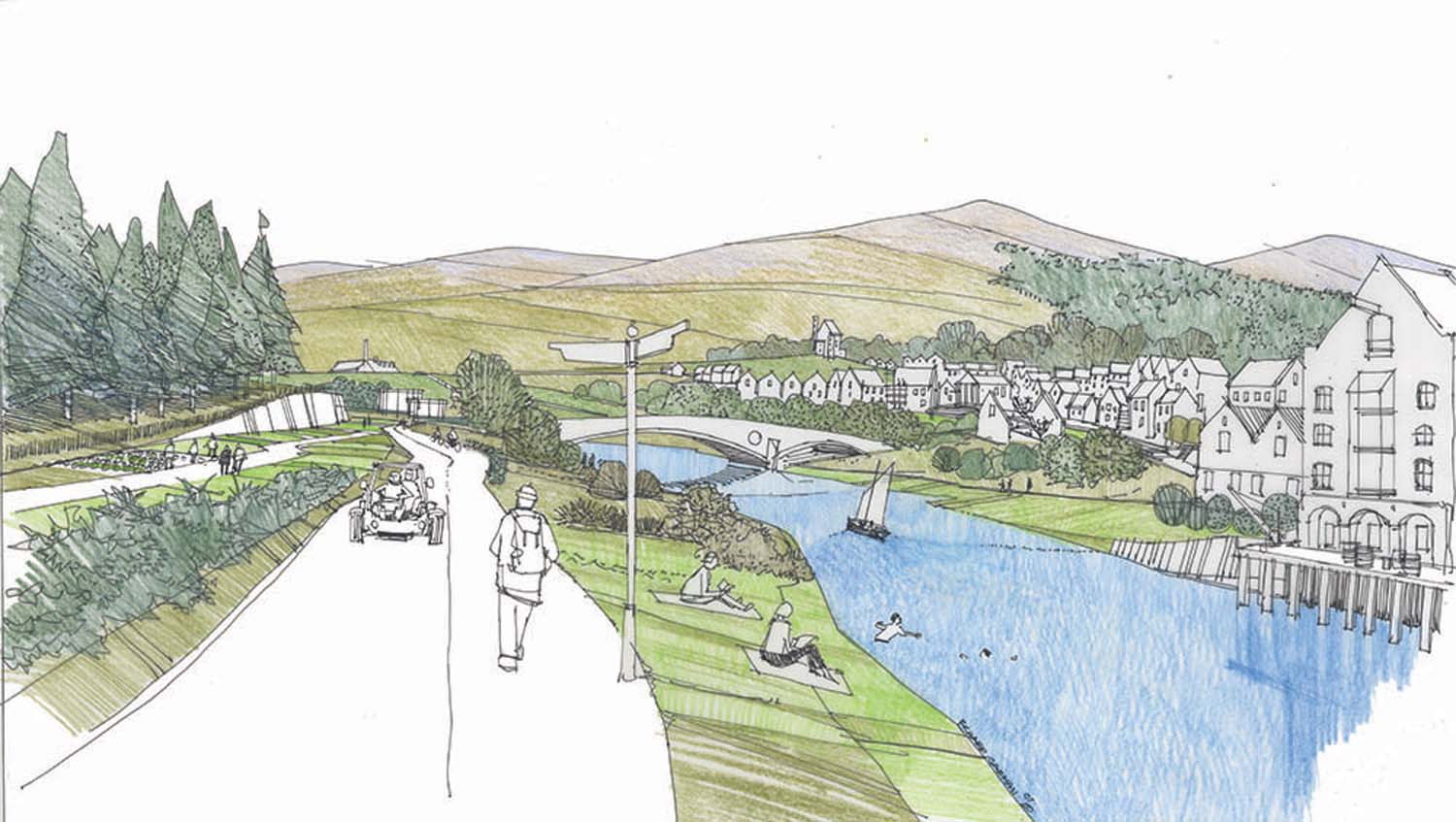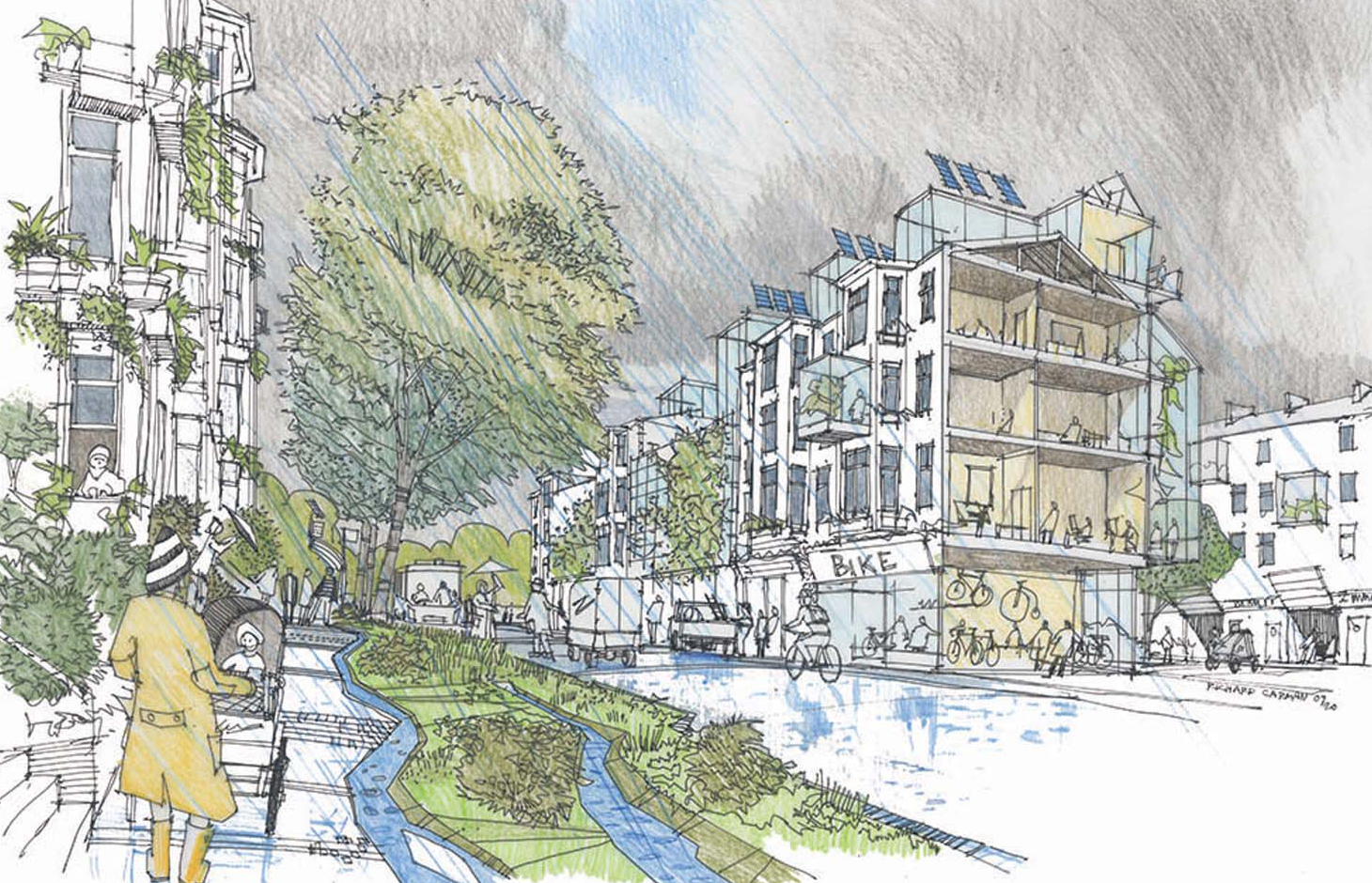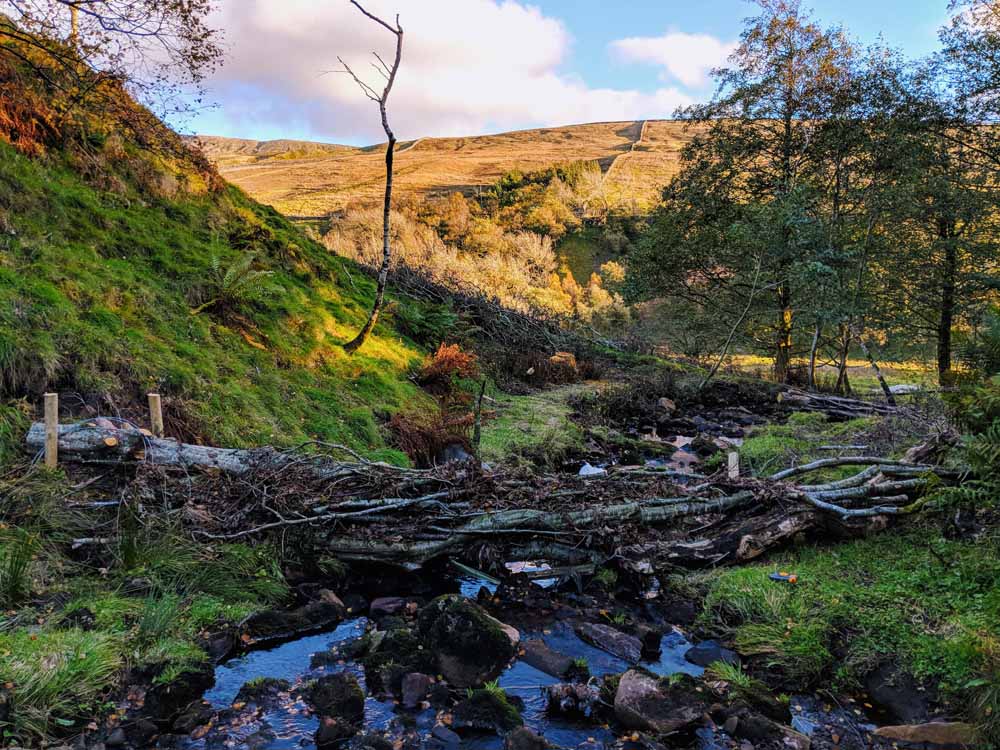Can blue-green infrastructure help manage the flooding issues faced in Kilmarnock?
Flooding has been a long-standing issue in Kilmarnock, impacting both its town centre and underutilised vacant land. This challenge, combined with concerns about the viability of development sites due to flood risk, called for an innovative approach to regeneration.
In 2021, East Ayrshire Council embarked on a place-based collaborative workshop to gain a better understanding on the potential of blue-green infrastructure, a nature-based solution that combines flood management with urban regeneration.
We gathered experts from the Key Agencies Group and the council to explore good practice examples that were being applied in Scotland.
Our aim was to see how these ideas could be applied to the council regeneration strategy for Kilmarnock’s town centre and south-central area. We explored:
- what an imaginative approach to flood risk management and blue-green infrastructure looks like
- how this can bring benefits for placemaking and regeneration
Key benefits of blue-green infrastructure for flood risk management
A blue-green infrastructure refers to a unified system that combines open spaces, green areas, water bodies and engineered solutions that mimics the natural ecosystem.
Benefits a blue-green infrastructure includes:
- planning and designing places that can thrive to a changing climate
- considering a holistic approach by moving beyond reactive solutions to proactive, nature-based flood management
- providing community benefits through high quality accessible green spaces that enhances well-being and liveability
- delivering multiple advantages by reducing flood risk, adding value beyond draining and cost-effective in the long-term
Scales of planning for blue-green infrastructure
During the workshop, we shared good practice in developing blue-green infrastructure strategies at four key scales. These are the:
Recordings from the event can be access here.
National policy on reducing surface water flooding
Scotland experiences significant surface water flooding. By 2080, an estimated 270,000 properties will be exposed to surface water flowing. At a national level, the 2019-20 Programme for Government outlines the need for an approach to transitioning to ‘blue-green cities’ and managing Scotland’s exposure to floods in the future.
At the workshop, David Faichney from Scottish Government, presented the ‘Water-resilient places – surface water management and blue-green infrastructure: policy framework’, which he helped to develop. This paper sets out a vision for the future, describing the role public sector stakeholders need to play to develop our blue-green infrastructure.
“It is not all about net zero. There is also a lot to be done to ensure we develop our climate resilience so that we can continue to flourish regardless of what our future climate holds.”
– David Faichney, Scottish Government
“It is not all about net zero. There is also a lot to be done to ensure we develop our climate resilience so that we can continue to flourish regardless of what our future climate holds.”
– David Faichney, Scottish Government
(2024 update: National Planning Framework 4 strongly supports the development of blue-green infrastructure in Scotland, setting out a clear policy framework by promoting its integration into planning for a more sustainable and resilient Scotland.)
Key learning points
- Scotland prioritises building climate-resilient places, with blue-green infrastructure playing a crucial role in managing future flood risks
- Flood management is moving beyond simply reacting to floods, emphasising proactive design with blue-green solutions
- Designing towns and cities must consider flood risk from the outset, favouring flood avoidance and resilience
- Effective flood management requires collaboration across different sectors to minimise flood impacts
- Blue-green infrastructure projects should be designed to provide high-quality green spaces and improve the lives of local residence

Exploring flood resilient landscapes at a strategic scale
Creating flood resilient landscapes provides an opportunity to correct past mistakes, when looking across a whole region. Our urban centres have often been designed away from riversides. Future plans and designs need to reflect our continuous relationship with our natural environment and a blue-green infrastructure can help to do so.
Nick Bowen, our design panellist highlighted several case studies including Greendyke Climate Ready Park, roof gardens at Queen Margaret University and Bertha Park in Perth.
Lucy Filby, LENs Lead, showcased how Landscape Enterprise Networks (LENs) can take a regionally focussed approach to flood management.
Key learning points
- By taking a land-scale approach, blue-green infrastructure solutions can address historical planning mistakes by reconnecting urban centres with natural environments
- Upstream interventions such as restoring natural habitats and promoting low-tech methods (e.g., beaver dams) can significantly improve flood resilience
- Sustainable Urban Drainage Systems (SuDS) should go beyond just drainage, adding value through improved aesthetics and functionality for surrounding areas
- River channels should be redesigned to incorporate flood control, recreation and biodiversity considerations
- Blue-green infrastructure offers cost effective advantages over traditional solutions while delivering benefits for various stakeholders or agencies
- Local businesses should be involved in implementing blue-green projects to ensure they contribute to and benefit from these solutions

Assessing porosity at a townscape scale
At this scale, we assess how we can improve the porosity of our neighbourhoods. Porosity refers to the empty space in between materials, such as rocks.
Fiona Stirling, Landscape Architect from NatureScot showcased good practice in greening our urban area. She focussed on the Sheffield Grey to Green scheme.
“No matter what the size or type of space, there is always potential to plan for nature-rich schemes that benefit people and wildlife… yes water storage but please so much more!” – Fiona Stirling, Nature Scot
Grant Vanson, Flood Risk Management Team Lead from the Scottish Government shared some of the key learnings for town centres across several different scales.
Finally, Stephen O’Malley, our design panellist looked at a range of projects across the UK that took a more positive look at place and incorporation of blue-green infrastructure to our streetscapes.
Key learning points
- Implementing projects like Sheffield’s Grey to Green scheme demonstrates the value of green spaces in urban environments
- SuDs approaches across the UK have looked at building up flood mitigation through a more decentralised than volume-mitigation approach
- Establish a clear long-term vision for blue-green infrastructure and collaborate across departments to achieve shared goals
- Utilise creative design approaches to create multi-functional blue-green solutions that address various urban challenges
- Connect flood management strategies with broader regeneration plans and consider incorporating flood mitigation into smaller-scale projects
- Prioritise long-term planning, high-quality materials, and establish clear maintenance plans for blue-green features
- Prioritise nature-based solutions that ensures nature and design spaces that benefit both people and wildlife by creating greener and more liveable townscapes

Reviewing blue-green infrastructure at a site-specific scale
To manage flood risk effectively, land needs to be in the public interest, but innovative blue-green infrastructure approaches have to be taken at a site level.
David Stewart, Senior Policy Officer from Scottish Land Commission, discussed good practice in regenerating brownfield sites for community benefit. He also showcased good practice in land assembly overseas in Wuppertal, Germany, Hilversum, Netherlands and Biel, Switzerland.
Helena Huws, A&DS panellist and Head of Destination Development for Scottish Canals, showcased work on infrastructure, regeneration of Speirs Locks, and Glasgow’s Smart Canal Project in her presentation.
Key learning points
- Public sector control of land, especially brownfields, allows for blue-green solutions that benefit the community
- Collaboration between public and private sectors reduces risks and costs for both sides, leading to successful projects
- Blue-green features can transform underused areas into thriving spaces, overcoming the challenges of post-industrial decline
- Carefully planned blue-green infrastructure near water features can unlock economic potential for surrounding and creates a ripple effect for social and environment improvements

Further information
Follow the links below to explore more interventions not mentioned above.
Townscape interventions
- “Avenues” project, Glasgow
- Anderston Station, Glasgow
- Greener Grangetown, Cardiff
Site-specific interventions
- Hamiltonhill Claypits, Glasgow
Next steps
We are continuing to work with the local authority, landowners and the Key Agencies Group to support positive steps for flood resilience in Kilmarnock. Using the project as a case study, the lessons learned here will be applied further to other flood resilience strategies across Scotland.
Supporting planning authorities with Local Development Plans
In 2023, the Key Agencies Group launched the Collaborative Local Development Plan offer in recognition of the challenges and opportunities that lie ahead for all involved in delivering on the ambitious new policy context set out in National Planning Framework 4 and Local Development Planning Guidance at a local level.
The Key Agencies Group confirmed Six local authorities for their diverse characteristics, providing a rich foundation for pulling out learning that can benefit other places.
About the Key Agencies Group
The Key Agencies Group comprises a group of public bodies that are recognised as supporting the delivery of culture change through improved joint working in the built environment. They have a key role in the delivery of Scottish Government’s aim of creating a more successful country, with opportunities for all of Scotland to flourish, through increasing sustainable economic growth.
Header image: A leaky dam, inspired by beaver dams, designed to reduce the flow of water upstream and use locally sourced materials such as logs. Image credit: Zora Van Leeuwen. Thanks to Raeburn Farquhar Brown.

